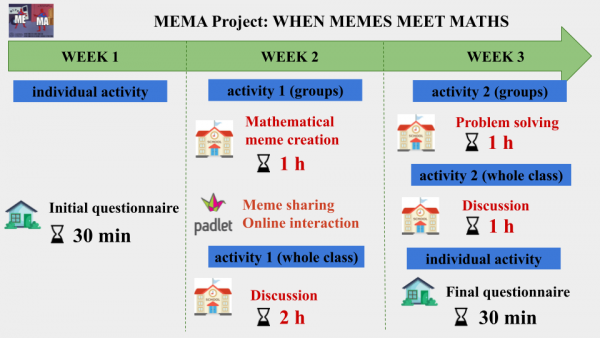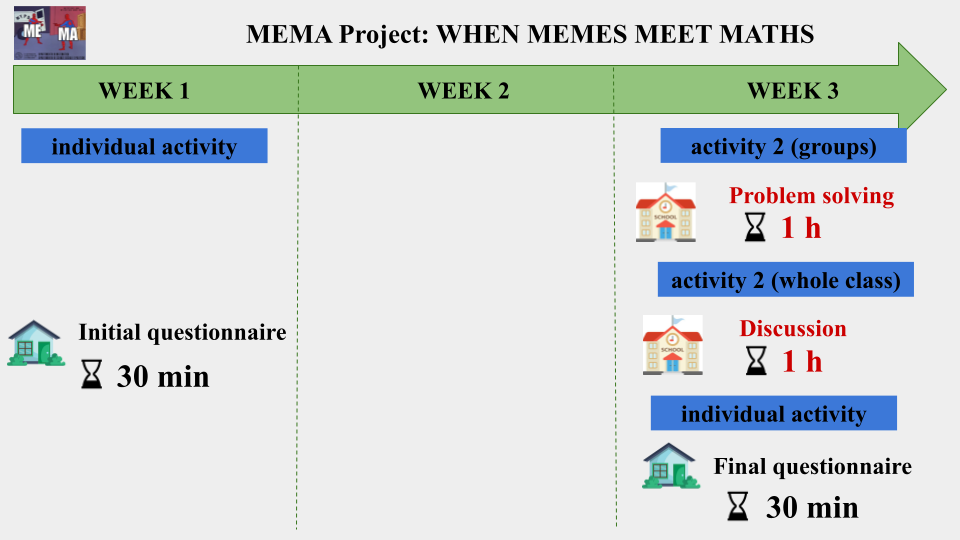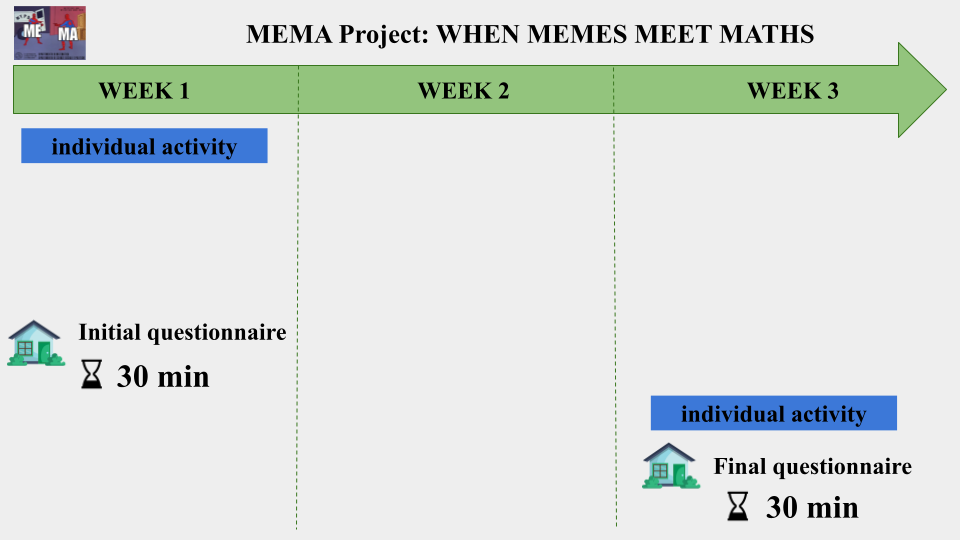Experimental design
The experimental design of the MEMA project is based on two core activities to be carried out in class one week apart, focusing on topics already covered by the class and designed to support the systematization and consolidation of knowledge. In the first activity, students work in small groups to create mathematical memes (1h) on curricular topics chosen by the teachers and share their creations on a digital sharing platform (Padlet); they then participate in a class discussion (2h) about the memetic and mathematical content of the created memes. In the second activity (2h), students, again in small groups, solve problems on the same topics addressed in the memes, ideally connecting the mathematical concepts to the memes they created, and then compare their solutions in a class discussion.
Students‘ Mathematics Capital (MC) is investigated through an initial questionnaire, while qualitative observations of both phases provide relevant data on how MC relates to what students do and the roles they assume during the different activities. Perceived Class Cohesion (PCC) is investigated through pre- and post-intervention questionnaires. The joint analysis of MC and PCC allows for the exploration of whether there is a relationship between students’ Mathematics Capital and their perception of increased class cohesion. If such a relationship emerges, qualitative data can help us understand to what extent this link is correlated with their participation during the meme activities, offering insights into how mathematical memes intertwine with students’ Mathematics Capital and the social dynamics within the class.
Given the one-year project duration, design choices reflect time constraints for experiments and data analyses. Experiments will occur from Dec. 2024 to Feb. 2025 in an Italian secondary school, exploring two dimensions: vertically, across grades 9, 11, and 13, to observe whether students’ maturity affects results; horizontally with three grade 11 classes, one participating in the full experiment, one in problem-solving activities only, and a control class.
DECEMBER 2024 GRADE 13 | ||
JANUARY 2025 GRADE 11 SECT X  | JANUARY 2025 GRADE 11 SECT Y | JANUARY 2025 GRADE 11 SECT Z |
FEBRUARY 2025 GRADE 9 |
Hypotheses, Experimental Design, Data Measurement, and Analysis
Objectives and Hypotheses
The project explores how math meme-based teaching activities (MEMA) influence students’ Perceived Class Cohesion (PCC). The main hypotheses are:
- H1: Perceived Class Cohesion (PCC) increases more after the MEMA activity than after a traditional teaching activity or in the absence of any activity.
- H2: The effect of the MEMA activity on PCC is moderated by the students’ level of Mathematics Capital (MC).
- H3: The MEMA activity is particularly effective in engaging students with low MC (qualitative assessment).
Experiment Structure
The study adopts a randomized experimental design with three conditions:
- Control Group: Students complete the PCC and MC questionnaires in the first week. They do not participate in any additional activities in the second week and complete the PCC questionnaire again in the third week.
- Treatment Group 1 (Traditional Activity): Students complete the PCC and MC questionnaires in the first week. In the second week, they do not participate in any additional activities. In the third week, they engage in a traditional group activity (collaborative problem-solving in mathematics), followed by the PCC questionnaire.
- Treatment Group 2 (MEMA + Traditional Activity): Students complete the PCC and MC questionnaires in the first week. In the second week, they participate in the MEMA activity (creation and sharing of math memes in groups, followed by a class discussion). In the third week, they engage in the same traditional activity as Treatment Group 1, followed by the PCC questionnaire.
Sampling and Randomization
The research involves five classes from an Italian secondary school (one first-year, one fifth-year, and three third-year classes). The three third-year classes are randomly assigned to one of the three experimental conditions, ensuring a controlled comparison. The first-year and fifth-year classes participate only in the qualitative analysis of the MEMA activity.
Measurements
- Main Variables:
- Perceived Class Cohesion (PCC): Measured through a validated questionnaire (Leo et al., 2023) before and after the treatment.
- Mathematics Capital (MC): Assessed with a questionnaire adapted from the “Science Capital” concept by Archer et al. (2015), administered before the treatment.
- Qualitative Assessment (H3): Direct observations and feedback collected from teachers and students during and after the MEMA activity to analyse student engagement, especially those with low MC.
Data Analysis
- Hypothesis H1: A linear regression analysis will assess whether PCC increases more in the treated groups (MEMA or traditional activity) compared to the control group, controlling for initial PCC values.
- Hypothesis H2: A moderation analysis will test the interaction between the MEMA treatment and MC levels on changes in PCC.
- Hypothesis H3: A qualitative thematic analysis will identify engagement patterns among students, focusing on those with low MC.
This approach allows for the exploration of both quantitative changes in class cohesion and qualitative dynamics that characterize student interactions during the activities.
Link to Experiment Pre-registration:
For more information and details regarding the experimental design of the MEMA project, consult the pre-registration link available on OpenScienceFramework: https://osf.io/eaq3f
